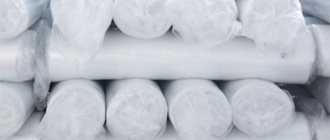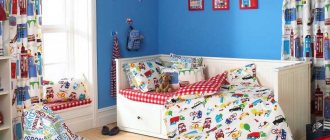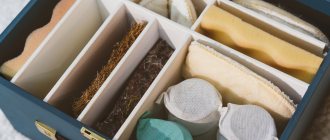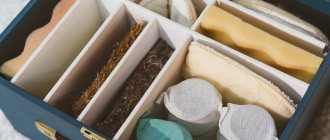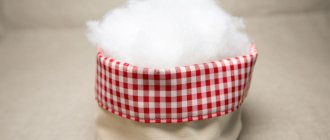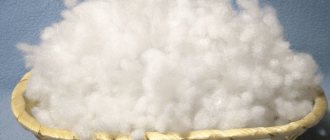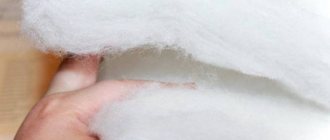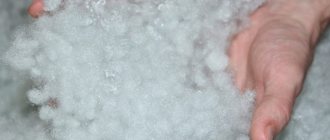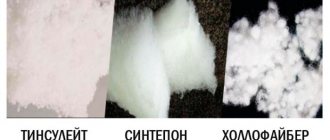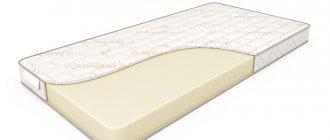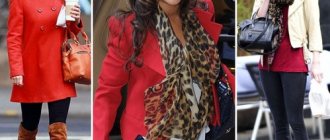Holofiber is a modern filler that is used to make bedding and outerwear. It is warm and light, durable and reliable material with a long service life. However, it requires compliance with certain care rules.
This filler is often used to make children's items, including a winter envelope, overalls and blankets for newborns. After all, this is a safe material that does not cause allergies. In this article we will look at the pros and cons of holofiber. Let's find out how to care for products with this filler.
Characteristics and features of a down jacket
It is worth noting that the most common insulation is down, which is a natural constant temperature saver, while holofiber can be classified as a synthetic material. Also, we should not forget that the cost of jackets with such fillings differs significantly from each other. Answer the question: “what is better – down or holofiber?” - advice from manufacturers and sellers of such goods will help.
A women's, children's or men's down jacket with down filling is considered to be of the highest quality and the warmest. But the cost of such a product will be high, since the presented jacket includes white goose down. A large number of manufacturers today can reduce the cost of down jackets by using gray down. Then everyone will be able to buy the product at a reasonable price, although the color of the filler will not affect the quality in any way.
Natural insulation - down - is a natural material that is designed to protect against severe frost during the cold season. A good down jacket should include the following ratio - 60% down and at least 40% feather. Ideal winter outerwear should contain at least 90% down and only 10% feather. If the volumes of such insulation in the product are equal to each other, then this model will not protect a person from severe frost; it can be worn at air temperatures not lower than zero.
Disadvantages of down filling
To fully determine what is warmer – down or holofiber, you also need to learn about the disadvantages of products made from natural materials. Every person should remember that when choosing outerwear for the cold season, one must take into account whose feather was used.
The best option is a goose. Unscrupulous manufacturers may produce jackets made from chicken feathers, which are incredibly brittle and do not provide the necessary volume to retain heat.
The main disadvantages of down and feathers can be identified:
- difficulties during washing (it is best to take such clothes to dry cleaning);
- the likelihood of an allergic reaction;
- fluff is a favorable environment for the reproduction of a large number of mites.
Properties of holofiber filler
The holofiber coat is incredibly light and warm.
This material is a hollow siliconized synthetic fiber that has high thermal insulation. It is worth noting that a specially designed silicone coating can prevent the accumulation of moisture inside the insulation. The presented material allows for a high degree of insulation. The silicone coating prevents the regular accumulation of moisture inside the holofiber, resulting in excellent elasticity and warmth. A holofiber coat has low weight and volume, so it can achieve high thermal insulation parameters. Such a product will serve a person for a long time, and you can take care of it at home, periodically wiping it with a damp cloth. This filler will be a pleasant surprise for those who until now have preferred exclusively down jackets.
Characteristics and description of the material
Holofiber is a synthetic non-woven fiber, which is similar in structure to padding polyester. But unlike the latter, no glue is used in the manufacture of the material, which makes the filler safe and environmentally friendly. In this case, the fiber is bonded by soldering at high temperature.
Holofiber has a hollow, hollow and porous structure. The air that accumulates inside provides high sound and heat insulation. It creates elasticity of the material, traps dust particles and does not become dirty for a long time.
Holofiber is used in various fields. For example, in construction it is used to fill walls in houses as heat, sound and noise insulation.
Holofiber is most widely used in light industry. It forms a reliable heat-insulating lining for clothing and hats. In addition, the material increases the elasticity of products and allows them to retain their shape after repeated deformation.
In furniture production, filler is used to fill sofas and armchairs, armrests, backs and seats. It is also useful for pillows, blankets and mattresses. In addition, holofiber is sometimes used to create filters in air conditioning and ventilation structures.
Advantages of holofiber material
This material is used as an excellent alternative to down. The following advantages and disadvantages of holofiber can be highlighted:
- The material does not accumulate excess moisture inside itself. This is especially important if a person is in the field, where there are difficulties with drying things.
- Holofiber jackets perfectly restore their original shape after severe crumpling. This applies to packing and storing clothes during the summer months.
- This material is hypoallergenic.
- Caring for a product made from holofiber is as simple as possible. You can wash it in any washing machine, but you need to choose only gentle modes and use slightly alkaline powders.
Types of holofiber and their application
Holofiber is available in 3 types: granules-balls, canvas and plates.
- Granule ball is the most common and familiar type of filler. The fibers twist to form balls ranging in size from a pea to a ping pong ball. This form of material holds its shape well, does not get knocked down or deformed - it is used to stuff pillows, toys, used as a filler for blankets and gives a three-dimensional shape to decorative items.
This insulation has no negative aspects. Except that it is slightly inferior in heat capacity to a goose feather.
- Non-woven fabric. Holofiber in sheets is available in different thicknesses from 60 to 4000 gm.sq. The thinnest canvas is used in landscape design. Fabrics with a density of 100 to 300 gm/sq are used as insulation for clothing. Denser fabrics, due to their thickness, density and elasticity, are excellent for making mattresses and upholstered furniture. There are three main types of furniture holofiber: there are also hard fabrics (hard) for creating a frame and flooring, medium (medium) for the top layer and soft (soft) for quilted elements and decorative elements.
Holofiber, due to its structure, is very durable. It does not deteriorate due to physical stress such as squeezing, washing and the like.
- Plates (layers, mats) are produced for construction needs; they are an excellent insulation and sound insulator. Both soft and hard pressed mats are available.
Some types of material are used in the space and aviation industries, as well as in arranging ventilation.
Different types of holofiber are also used in light industry, mechanical engineering, the space industry and aviation.
Varieties of holofiber
Material such as holofiber can be divided into sheets, layers and balls. In turn, the canvases come in the following types:
- Software The composition of this material is exclusively hollow, highly crimped polyester microfiber, which is presented in the form of a spiral or springs. Soft holofiber jackets are quite soft and pliable. The presented type is widely used for the manufacture of outer layers of clothing, children's furniture and many other things. It can be used for clothing of a newborn baby.
- Medium. The canvas is quite sensitive to the microclimate of each person. It is used similarly to “software”. The main difference is the density, thanks to which manufacturers produce children's envelopes, pillows, coats and other outerwear from this material.
- The volumetric filler is quite voluminous and light. It is widely used during the production of outerwear.
Functional qualities of holofiber
It is worth noting that holofiber acts as insulation and filler.
This material can be used as a high-tech alternative to the well-known padding polyester, batting, wool, latex, foam rubber, and mineral wool. People of different ages were able to appreciate such insulation as holofiber. Reviews about it are only positive, so many consumers are satisfied with their purchase. The areas of application of this versatile material are varied. It is used for sewing and filling furniture, as well as as insulation for apiaries, filler for outerwear and children's toys. This list can be continued for a long time. Holofiber has proven itself best as insulation for outerwear. It is thanks to him that a large number of people feel great during the winter and cold months.
So which is better - down or holofiber? Experts recommend giving preference to the second option. It is capable of excellent heat retention thanks to its unique fiber structure, which is presented in the form of a spiral spring, where a special air cushion is formed.
What to choose: holofiber or Thinsulate
Today there are a lot of different insulation materials for clothing. Synthetic materials will complement modern Thinsulate. This is the warmest synthetic filler that will keep you warm even at temperatures below minus forty degrees. The material is used for the manufacture of clothing and special suits, for filling covers, bedding and soft toys.
Hollofiber and Thinsulate are united by the fact that both materials are characterized by strength and durability, elasticity and high thermal insulation properties, resistance to moisture and wear, light weight and comfortable use. They retain heat well and retain their shape after deformation, do not cause allergies and are environmentally friendly.
What to choose, Thinsulate or Holofiber, depends on the conditions of use. For harsh and extreme climatic conditions or as sports equipment or a suit, it is better to choose Thinsulate. Holofiber is more voluminous and affordable. It is suitable for everyday wear.
Positive properties and qualities of holofiber
Products made from this material can serve their owner for quite a long time.
Holofiber is an absolutely non-toxic material, so it will not cause allergies in people. It also does not absorb various odors from the environment. The products are not flammable, so when choosing, consumers prefer material such as holofiber. Reviews from people who have worn outerwear with this filling are most often positive and recommendatory. When wearing a product based on holofiber, you don’t have to worry about it getting wrinkled or losing its neat appearance, since this material always returns to its shape. In especially cold months, such a filler will retain heat perfectly.
Holofiber 350 at what temperature
Thanks to one baby girl!
Insulation materials can be natural or synthetic.
Synthetic:
Manufacturers most often indicate in the product instructions: “insulation – 100% polyester” (very rarely specifying what kind of synthetic insulation).
Sintepon - polyester fibers. The adhesion of fibers to each other can be carried out in two ways: gluing and thermal bonding. Adhesive padding polyester is not environmentally friendly due to the use of glue, it quickly deforms and “cakes” under loads and washing, it is heavy, has low thermal insulation ability and breathability. Currently, it is practically not used in the production of children's clothing; it can be found only in the cheapest products.
Thermally bonded padding polyester is environmentally friendly and hypoallergenic.
Sintepon is durable, but unsuitable for cold winters. Therefore, models based on padding polyester are more suitable for the off-season. In jackets with synthetic padding, a child will be comfortable only at a temperature not exceeding -10°C.
Sintepon can have a density from 50 to 600 g. per square meter. One layer of padding polyester or several can be used in clothing.
The thickness of the padding polyester is designed for different temperatures:
100 g – this is autumn/spring – approximately from 0... + 5 to + 15...;
250 grams is the demi-season - from +10 to -5 approximately.
300-350 – cold winter, down to about -25.
Hollowfiber, polyfiber, fiberskin, fibertek.
Such synthetic insulation consists of fibers that have the shape of springs or balls. These components contain cavities, so products with such insulation hold their shape well.
The advantages of holofiber include high thermal protection, environmental friendliness, and dimensional stability due to the springy structure of the fibers. Holofiber does not absorb moisture at all and breathes well.
A children's overall that can withstand temperatures down to -25°.
Isosoft (ISOSOFT) is a modern synthetic insulation with a heat-sealed surface, made from fibers shaped like balls. The balls do not communicate with each other and contain cavities, which is why the isosoft product holds its shape and heat well. A special microcellular structure does not allow cold air to penetrate inside, while retaining warm air. Isosoft clothing creates an ideal microclimate around the body, depending on the child’s activity and the weather. They have high heat-shielding properties. Winter clothes with isosoft can withstand temperatures of -25C.
40-70 g/sq.m. – warm autumn-spring;
100-150 g/sq.m. – cold autumn-spring, warm winter;
200-300 g/sq.m. - frosty winter.
Thinsulate is considered one of the best synthetic insulation materials. Permissible temperature range for Thinsulate: up to -30°
Thinsulate insulation consists of unique microfibers, which are 50 to 70 times thinner than a human hair, their diameter is from 2 to 10 microns. There is a layer of air around each fiber. The finer the fibers, the more insulating layers there are in the clothing. This makes Thinsulate™ insulation 2 times warmer than the warmest down.
Disadvantages of holofiber
Many people take the process of buying winter clothing such as a jacket very seriously. Hollow fiber or down is the personal preference of each consumer. It should be noted that a down product can cause allergic reactions in a small child or an adult, so jackets with such filling are not suitable for everyone.
The only drawback of holofiber can be identified - the manufacturer’s promise that outerwear will not accumulate static electricity.
How to properly wash a holofiber jacket?
It is difficult to determine what is warmer - down or holofiber? These two materials are unique because they have their own advantages. Holofiber has proven itself to be worn well and is an excellent filler for outerwear. This material will never harbor ticks and many other parasites.
Washing and caring for holofiber jackets is quite simple. They can be put in regular washing machines. When something gets very dirty, you just need to soak it for a while. After this, dirty areas such as the collar, cuffs and pockets should be treated with a brush. The jacket can be washed perfectly with regular washing powder at a temperature of 50 degrees. All of the above recommendations will help readers not only determine what is warmer - down or holofiber, but will also tell them how to choose the right outerwear for each family member.
Pros and cons of holofiber
Manufacturers and consumers highly value holofiber for a number of useful and unique properties:
- strength and resistance to deformation - thanks to the reliable adhesion of the fibers, the material cannot be torn by hand;
- durability and ease of care - the products can be washed both by hand and in a washing machine.
- hygienic - can be washed often, it will not harbor moths, mites, mold or mildew;
- breathability and moisture resistance - products dry quickly and have a “breathing” effect;
- excellent heat-regulating properties;
- hypoallergenic and environmentally friendly during production and operation;
- lightness and softness;
- fire resistance - when exposed to high temperatures, the filler does not burn, but slowly smolders.
Products containing this filler can be used by both adults and children.
There are few disadvantages to products made from holofiber. Some consumers note that they feel hot in things with this insulation; this applies not only to clothing, but also to bedding. The reason lies in some individual characteristics of the body. You should not wash it in aggressive modes or at high temperatures - it may lose its elasticity and become stiff.
If you wash an item filled with holofiber often and in too hot water, the structure of the fibers may collapse.
Note! Holofiber is recommended for use for children's things, toys and bedding, as it is completely harmless.
Let's consider the advantages of using holofiber in different areas.
- In clothes
Clothes made from holofiber are warm, light and absolutely hypoallergenic, which means they are suitable even for the smallest children. It can be washed frequently and will dry quickly after washing. A jacket or down jacket will keep you warm even in harsh winters at temperatures below -25⁰ C. In clothing, holofiber performs no worse than Thinsulate (a type of synthetic down with high thermal insulation and consumer properties, with this filler it is comfortable down to -60⁰ C) and loses only in ability to retain heat, while it is much cheaper than Thinsulate and is quite suitable for our winters.
Products with filler do not wrinkle, easily return to their original state, and do not lose their properties over the entire service period.
- In pillows and blankets
Hypoallergenic and eco-friendly soft holofiber pillows will give both children and parents a restful sleep, and under light, breathable blankets made of this material it is not cold in winter and not hot in summer.
Such blankets and pillows are very hygienic - they will not harbor bed mites, and washing them is no more difficult than a jacket. For this, the most common washing powder and delicate mode at a washing temperature of 30-40 ⁰C are suitable. You can wring out and dry in the machine and after drying the synthetic filler will not lose its shape and elasticity.
The fibers allow air to pass through themselves well, and products filled with them have a “breathable” effect.
- For furniture production
In furniture production, all types of holofiber are used, usually special brands that have a denser structure and increased elasticity. Decorative pillows and bean bags are stuffed with soft elastic balls. Hard compressed fiber boards are suitable for the production of springless mattresses, including children's ones.
These slabs create an alternative to traditional coconut and foam rubber; they are cheaper, but at the same time more environmentally friendly and durable.
- In construction
In this industry, holofiber has an unlimited scope of application. It has proven itself to be an excellent industrial and household insulation material - it can be used to insulate a building from the foundation and basement to the roof. “Friends” with different building materials - concrete, stone, brick, wood. The material has become a godsend for insulating houses made of timber and frames, including complex architectural forms in the form of domes, monocells, etc.
It is flexible and resilient, reliably filling all the necessary space, regardless of the weather and season. Separately, it should be noted the high soundproofing properties of the sheet material and its non-flammability, which is important for frame and wooden residential buildings.
This insulation is non-hygroscopic and does not harbor fungi and mold.
- In decorative products
Holofiber can be used wherever it is necessary to add volume to the product:
- decorative pillows and ottomans
- toys and souvenirs
- bedding and houses for pets
- different types of handicrafts and hobbies
Parents can give these toys to their children without fear. This filler is also safe for newborns.
